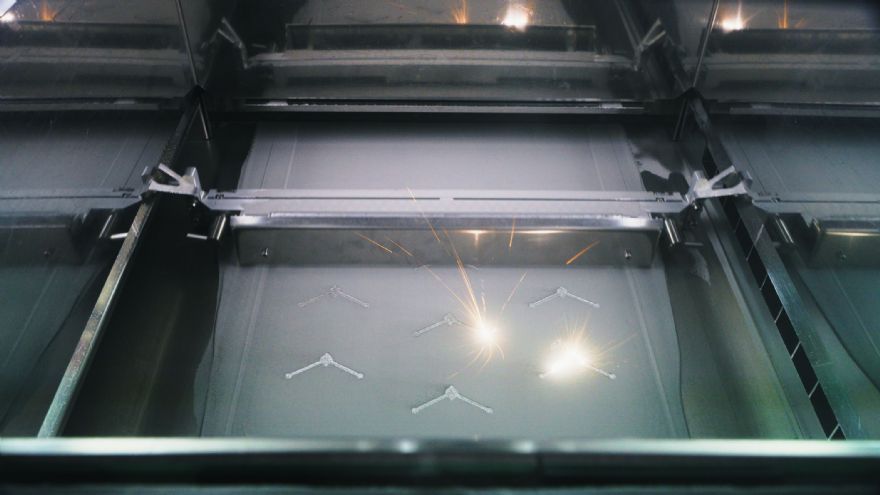 Tibial tray build with Tempus technology
Tibial tray build with Tempus technologyReducing cost per part is a critical factor in driving additive manufacturing (AM) adoption. The dominant factor in cost per part for most metal AM components today is the time spent building the component on the machine.
Marc Gardon, EMEA AM applications manager at
Renishaw Iberica, said: “Many businesses in the medical and dental industries are using AM technology to produce surgical instruments, implants and also patient-specific dental prosthetics and orthopaedic geometries; the business case is widely established in these sectors. Furthermore, AM is already a well-used manufacturing technology in a wide range of sectors including aerospace, defence, tool-making, motorsport and energy. However, AM has huge growth potential in multiple manufacturing industries, but for this to be realised, reducing cost per part is critical.
“To broaden the possible applications of metal AM, original equipment manufacturers (OEMs) have focused heavy research and development (R&D) efforts into increasing system productivity. For example, the development of multi-laser machines for laser powder bed fusion (LPBF) has helped quadruple productivity using the same machine footprint as existing systems.”
There are several options for OEMs looking to increase machine productivity, with the two most obvious being to increase machine size and boost laser power. However, both of these approaches would increase cost for the customer. To improve cost per part without driving up the entry barriers, manufacturers are looking at ways to optimise the AM process.
Mr Gardon continued: ‘In a LBPF process, the machine spreads a thin layer of fine metal powder, and then a high-powered laser selectively melts and fuses powder where structure is required, before adding a new layer. The process is repeated until a solid metal part is complete. One part of the LPBF process that Renishaw engineers have identified to improve overall productivity is mitigating wiper time — traditionally, the laser stops firing when the recoater spreads the next layer of powder.”
TEMPUS technology, a new innovation from Renishaw, incorporates a new scanning algorithm for the company’s RenAM 500 series of AM systems, which allows the laser to fire while the recoater is moving, enabling savings of up to 9sec per layer. Over the course of the build, the time saving adds up significantly. Higher time savings are typically achieved when building parts with thin, vertical features, but all part geometries can experience some productivity benefits.
Productivity gainsSpanish-based MADIT, a specialist in the use of metal additive manufacturing for industrial production, has trialled the new TEMPUS technology and achieved positive results, reducing the build times of parts by between 25 and 50% without compromising on quality. The time saving means MADIT has increased production from one to two shifts each day, increasing throughput.
MADIT tested TEMPUS technology on both its single laser and multi-laser Renishaw systems by producing a plate with 24 tubes of 1mm diameter, used in automotive system refrigeration. On the single laser system, build time was reduced from 36 to 26hr. On the multi-laser system, build time was reduced from 17 to 8hr, a significant time saving of more than 50%.
Mr Gardon added: “With productivity improvements lowering the entry barrier for metal AM, businesses can now both expand the use of AM into novel applications more easily, and upscale existing processes. Those already using AM can experience better margins, opening up the opportunity to invest in more equipment and to grow.
“It is hoped that productivity increases will drive down cost per part to accelerate the adoption of AM as a high-volume manufacturing process. With productivity gains making it easier to build a business case and meet demand for high volume applications, it is expected that AM will be able to meet its full potential in a wider range of manufacturing applications. For example, while AM is currently used in specialist automotive applications like F1 or supercars, it could become more widespread in general automotive manufacturing.”
He concluded: TEMPUS technology is built into the new Renishaw RenAM 500 Ultra models, which are available with quad or single-laser configuration. Existing RenAM 500 series customers can access TEMPUS technology as a paid-for upgrade. For further information on maximising productivity in AM, visit the website:
here.